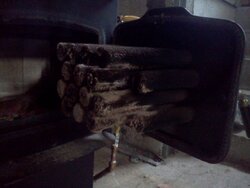http://worcester.craigslist.org/hsd/3512030169.html
this looks like somthing cobbled together in his garage. flex gas line to hook up?
New to Market- Heat water using an existing P61 Pellet stove. Can fit 38 and 45 stove with slight modification.
This is a heat exchanger plate that replaces the door glass to allow water to be heated water. This heat exchanger fills the alternative energy gap where it's currently cost prohibitive to heat water without purchasing a pellet boiler. This exchanger will heat water by absorbing heat energy 'on the margin' from an existing pellet stove. The pellet stove operates normally producing hot air, while this heat exchanger extends into the fire box to absorb heat energy. This heat energy is then absorbed by a custom copper water jacket located on the outside of the heat exchanger plate. There is no water in the firebox itself. This is a 'bolt in' installation, no holes to drill, no permanent modifications to the stove. Output rated at 15KBTU's/hr. Use stainless steel flex hose (such as NAT GAS flex pipe) to allow door to swing open.
Can be used to heat domestic hot water with additional 'side-arm' heat exchanger w/drain back tank for water heaters, or to add heat to existing water boiler on a return line.
All connections are brazed, heat exchanger can be run dry without damage. 1/2" NPT in and out.
Patent Pending. Made in USA. Item may have improvements to design. Picture is representative of item to shipped. Some assembly required.
Buyer responsible for all liabilities, damages, use, and installation with building codes by licensed professional.
Highly recommend using a Wilo-32 or Taco 009 circulator pump along with a drain back reservoir (vented to atmosphere) such as Alternative Energy Technologies DB-10-10XC. This will allow the heat exchanger in the stove to be isolated from existing systems and allow the stove to run dry and use only when needed via a thermostat controlling the circulator pumps.
NO HOLES TO DRILL! NO PERMANENT MODIFICATIONS!
Change out the door glass with this heat exchanger and heat your domestic hot water, Jacuzzi tub, or boost the temperature of the water returning to your existing boiler - 'on the margin' from your pellet stove.
If you have a solar water heating system, this can be used to supplement your water heating needs while the solar radiation is at it's lowest and still being green! No fossil fuel backup!
15K btu's/hr all day long.
Not recommended to be connected directly into critical applications or to replace primary heating sources.
If a power outage occurs, the pump will shut off and the water will flow in reverse via gravity to the drain back tank and out of the heat exchanger which helps reduce the hazard of producing steam. The copper water jacket can run dry.
Easy to clean!
Extra pictures showing heating exchanger installed in P61 stove. Runs great! Currently installed to heat domestic hot water. Haven't used any oil this season!
this looks like somthing cobbled together in his garage. flex gas line to hook up?
New to Market- Heat water using an existing P61 Pellet stove. Can fit 38 and 45 stove with slight modification.
This is a heat exchanger plate that replaces the door glass to allow water to be heated water. This heat exchanger fills the alternative energy gap where it's currently cost prohibitive to heat water without purchasing a pellet boiler. This exchanger will heat water by absorbing heat energy 'on the margin' from an existing pellet stove. The pellet stove operates normally producing hot air, while this heat exchanger extends into the fire box to absorb heat energy. This heat energy is then absorbed by a custom copper water jacket located on the outside of the heat exchanger plate. There is no water in the firebox itself. This is a 'bolt in' installation, no holes to drill, no permanent modifications to the stove. Output rated at 15KBTU's/hr. Use stainless steel flex hose (such as NAT GAS flex pipe) to allow door to swing open.
Can be used to heat domestic hot water with additional 'side-arm' heat exchanger w/drain back tank for water heaters, or to add heat to existing water boiler on a return line.
All connections are brazed, heat exchanger can be run dry without damage. 1/2" NPT in and out.
Patent Pending. Made in USA. Item may have improvements to design. Picture is representative of item to shipped. Some assembly required.
Buyer responsible for all liabilities, damages, use, and installation with building codes by licensed professional.
Highly recommend using a Wilo-32 or Taco 009 circulator pump along with a drain back reservoir (vented to atmosphere) such as Alternative Energy Technologies DB-10-10XC. This will allow the heat exchanger in the stove to be isolated from existing systems and allow the stove to run dry and use only when needed via a thermostat controlling the circulator pumps.
NO HOLES TO DRILL! NO PERMANENT MODIFICATIONS!
Change out the door glass with this heat exchanger and heat your domestic hot water, Jacuzzi tub, or boost the temperature of the water returning to your existing boiler - 'on the margin' from your pellet stove.
If you have a solar water heating system, this can be used to supplement your water heating needs while the solar radiation is at it's lowest and still being green! No fossil fuel backup!
15K btu's/hr all day long.
Not recommended to be connected directly into critical applications or to replace primary heating sources.
If a power outage occurs, the pump will shut off and the water will flow in reverse via gravity to the drain back tank and out of the heat exchanger which helps reduce the hazard of producing steam. The copper water jacket can run dry.
Easy to clean!
Extra pictures showing heating exchanger installed in P61 stove. Runs great! Currently installed to heat domestic hot water. Haven't used any oil this season!



